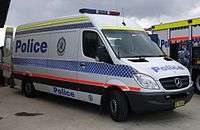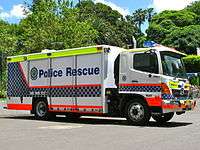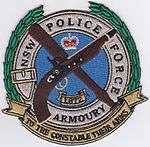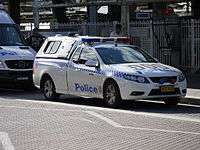State Protection Group
| State Protection Group | |
|---|---|
 | |
| Abbreviation | SPG |
| Motto |
Stamus Una (English: We Stand As One) |
| Agency overview | |
| Formed | 19th June 1991 |
| Headquarters | Sydney |
|
| |
| Parent agency | New South Wales Police Force |
| Notables | |
| Person |
|
| Significant operation(s) | |
The State Protection Group (SPG) is part of the Specialist Operations division of the New South Wales Police Force, having been established in 1991[1][2] to deal with extraordinary policing responses. The SPG directly supports police in high-risk incidents such as sieges with specialised tactical, negotiation, intelligence and command-support services. The unit also provides rescue and bomb disposal support, canine policing, and armoury services.
History
Established in June 1991, the State Protection Group replaced four former specialist units; the Special Weapons and Operations Section (SWOS), the Witness Security Unit, regional Tactical Response Groups and the Police Rescue Squad.[2] Later other sections were also added to the command including the Police Armoury, Negotiation section, Bomb disposal and Dog Unit. In recent years the Witness Security Unit was moved from the State Protection Group to the Anti Terrorism & Security Group.[3]
Roles
- Resolving siege and hostage situations, as well as armed offender situations;
- Providing a negotiation service in high risk and critical situations;
- Undertaking searches of premises in high risk situations;
- The arrest of armed and dangerous offenders;
- Escorting and securing dangerous prisoners in high risk situations;
- Providing support services for major operations;
- Rescue and bomb disposal operations;
- Counter-terrorism and hijacking operations;
- The escort and security of VIPs, internationally protected persons, Heads of State; and
- Providing specialist engineering services and supply of ammunition and firearms for the NSW Police Force through the Armoury.
Mission
"To provide extraordinary services to operational police in rescue, bomb disposal, high risk resolution, negotiation, specialised dog unit and Armoury services."[4]
Organisation
The SPG currently consists of the following sections:
- Tactical Operations Unit (TOU)
- State Protection Support Units (SPSU)
- Negotiation Unit
- Intelligence Unit
- Police Rescue and Bomb Disposal Unit
- Police Armoury
- Dog Unit
Tactical Operations Unit (TOU)

Since 1978, the Australian Government's National Counter-Terrorism Plan has required each state police force to maintain a specialist counter-terrorist and hostage-rescue unit (Police Tactical Group, aka police tactical unit).[5] The unit that now fulfills that role, the Tactical Operations Unit, has undergone a number of changes over the years.
Since 1945 the New South Wales Police Force has maintained a team of tactical police available for specialist operations with the creation of the 'Riot Squad' which consisted of a number detectives from '21 Division' to counter the number of armed hold ups that occurred after World War II.[6] Over the following years it became known as the 'Emergency Squad'[7][8] and in 1977 had its name changed to the 'Special Weapons and Operations Section' (SWOS) with its size and role expanding, including a full-time complement of 27[9] officers and 400 part-time officers across the State.[7]
In 1980 the Tactical Response Group (TRG) was created, becoming operational in May 1982, with units divided into groups of 25 officers across the four metropolitan regions with a primary role of responding to riots, demonstrations, disasters, saturation patrols and to support SWOS at emergency hostage/siege situations.[10] TRG officers were mainly drawn from the ranks of general duties police whereas SWOS were drawn from Detectives sections and branches.
In June 1991 both units were rationalised and dissolved with the creation of the Tactical Operations Unit with the aim of resolving high-risk incidents by containment and negotiation, with minimal or judicious use of force to be applied only as a last resort and based on full and careful assessment. Unlike the former SWOS and TRG, the TOU is a completely full-time assignment with a strength of 75 officers and is not responsible for riot control or crowd control situations, which are handled by the Public Order and Riot Squad (PORS). The TOU is available to provide extraordinary assistance to operational police in high-risk incidents such as resolving siege and hostage situations, as well as armed offender situations across the State on a 24-hour basis. The TOU also conducts 'high risk' arrest operations of armed and dangerous offenders such as Ivan Milat,[11] Malcolm Naden,[12] or those involved in firearm incidents such as bikie related shootings.[13] The TOU deals with at least 200 "high-risk" situations, including siege and hostage scenarios, each year across NSW.
The TOU is equipped with 'less-lethal' devices as well as specialist firearms and equipment for 'domestic' and counter-terrorist operations. Members of the TOU are equipped with a wide range of specialist firearms including Heckler & Koch UMP submachine guns[14] and tactical shotguns.[15] The TOU is equipped with a wide range of specialist vehicles including mobile command/support vehicles,[16] armoured Chevrolet vans[17] and two Lenco BearCat armoured Ford F550s.[18][19][20]
The TOU feature in an in-depth article of 'On Duty' magazine detailing selection criteria and fitness requirements amongst other operational facets.[21][22]
State Protection Support Units (SPSU)
The State Protection Support Unit provides specialist support to the Tactical Operations Unit in resolving high-risk incidents in regional New South Wales. The various State Protection Support Units across the State are involved in approximately 60 'high risk' operations per year, most of which are resolved prior to the operatives arriving on scene.[23]
Comprising part-time tactical operatives from non-metropolitan areas, the State Protection Support Unit consists of police whose primary duties cover a wide range of activities including general duties, highway patrol, detectiving and weapons training.
The types of operations that they can be called upon to undertake, in conjunction with the Tactical Operations Unit, include containing siege and armed offender situations; resolving siege and hostage situations; arresting armed and dangerous offenders, often in high-risk situations; conducting high-risk searches of premises; arresting angry members of the public who have used harsh language towards initial attending police and escorting and providing security for internationally protected persons, heads of State and holders of high office who are assessed and determined to be at risk. The unit also provides support services for high-risk major operations.[23]
Each year the State Protection Support Unit is involved in approximately 60 operations across the State which includes pre-planned operations and the execution of high-risk search warrants.[23] While primarily a regional resource, the State Protection Support Unit can be deployed throughout the State to assist the Tactical Operations Unit.
Approximately 220 SPSU officers are on call across the state under regional command.
The TOU is responsible for the initial selection and training of SPSU volunteers, followed up by monthly local training and an annual TOU re-certification camp. The SPSU officers also attend various training camps organised by Tactical Operations Unit to maintain consistency in their training levels.
As the SPSU is a part-time unit and are not responsible for counter terrorist operations (responsibility lies with the TOU) they are not trained or equipped to the same level as the TOU. SPSU teams are equipped with a range of specialist tactical gear including less than lethal munitions such as Tasers, beanbags as well as various shotguns and M4/M16 semi automatic rifles.
The range of skills SPSU operators possess include bushcraft and navigation, close quarter tactics, entry methods, ballistic shield operations, cordon and perimeter operations, advanced weapons training, and less than lethal tactics.[23]
Negotiation Unit
In 1979 the NSW Police ran their first Hostage Negotiator Unit course forming a part-time on call unit. In 1991 with the creation of the SPG the term hostage was dropped due to the variety of call-outs the unit was used for and a small full-time cadre established.[24]
At present under the supervision of a small full-time cadre, highly trained negotiators are on call across the state on a part-time, as-needed basis.[25] Negotiators work hand in hand with other units of the State Protection Group in order to resolve incidents peacefully.[5]
Roles and tasks
- Suicide intervention
- Persons with mental health issues
- Kidnapping/extortion
- Sieges/hostage situations
- Barricaded offender situations
- Escapees
- Warrants – search, high-risk warrant execution
- Family law matters
- Public order management
- National counter-terrorism incidents
Intelligence Unit
This unit provides intelligence information to negotiators and other TOU officers involved in high-risk incidents. Such intelligence may include information on people involved (offenders, hostages or suspects), or the provision of plans and photographs of premises.[4][2]
Police Rescue and Bomb Disposal Unit

Originally created in 1942 as the Police Cliff Rescue Squad for the express purpose of recovering the bodies of suicide victims, or rescuing persons trapped on cliffs, the Police Rescue and Bomb Disposal Unit has undergone numerous changes and expansions over the years.[26] Apart from responding to 000 (emergency calls) calls, the Police Rescue Unit provides specialist search and rescue support of operational police in situations of any risk category. This support extends from searches for evidence, to working with negotiators at extreme heights.[26]
Police Rescue operators are trained to use equipment such as Jaws of Life, metal detectors, trapped person locaters, sophisticated communication equipment and cutting tools etc. These officers are experts in abseiling, climbing, single rope techniques and stretcher escorts with cliff machines.
The Units core responsibilities include:[27]
- General Rescue,
- Specialist Support,
- Land Search and Rescue
- Bomb Response and Disposal.[28]
Some of the Rescue Unit's responsibilities and challenges include:[29]
- Rescuing people trapped in difficult high or deep places such as mines, storm-water drains, cliffs, scaffolding and remote places.
- Rescuing people involved in industrial, traffic, railway and aircraft accidents or who may have become trapped in household equipment, machinery or playground equipment.
- Providing power or lighting in emergencies or for police operations
- Rescuing livestock and animals in accidents
- Working in toxic or hazardous environments

In 1993 the Department of Defence handed over bomb disposal responsibilities to the NSW Police Force. The Bomb Disposal section was established within Forensic Services and then in 1997, the section was relocated to the SPG.[30] Prior to the 2000 Sydney Olympic Games, the Bomb Disposal section was amalgamated with the Rescue Unit.
The Police Rescue and Bomb Disposal Unit is based in Alexandria (Sydney). Decentralized units are based in the Blue Mountains,[31] Newcastle, Goulburn, Bathurst, Lismore and Oak Flats [32] (formerly Wollongong). The mostly part-time decentralized units are responsible for rescue and bomb appraisal operations within their local area and provide specialist support tasks for operational policing that cannot be provided by other units or sections.[33] Established in 2015, the newly formed Western Region Police Rescue Squad comprising general duty officers from Moree, Narrabri, Tamworth, Quirindi, Werris Creek, Armidale and Bourke provides specialist operational support to various police units across the Western Region.[34]
The unit was the subject of an Australian ABC television series (1991–1996) and a 1994 feature film, Police Rescue.
The Police Rescue and Bomb Disposal Unit celebrated its 75 year anniversary in 2017[35] with the Blue Mountains Police Rescue Squad its 50th anniversary in 2018.[36]
Rescue Squad Major Involvements
It is estimated that the unit has attended over 300,000 jobs in the past 60 years.[37] The Unit has been involved in some of the States, and Australias, largest incidents including the following:
- 1966 Wanda Beach Murders
- 1974 Cyclone Tracy
- 1977 Granville rail disaster
- 1978 Sydney Hilton bombing
- 1979 Sydney Ghost Train fire
- 1989 Newcastle earthquake
- 1989 Kempsey bus crash
- 1997 Thredbo landslide
- 1999 Glenbrook rail accident
- 2003 Waterfall train disaster
- 2007 Sydney Harbour ferry/pleasure cruiser crash[38]
- 2008 Sydney Harbour boat collision
- 2009 British backpacker Jamie Neale search[39]
- 2011 Mosman collar bomb incident[40]
- 2011 Parramatta Bomb Hoax/Hostage Incident
- 2013 New South Wales bushfires
- 2014 Sydney Lindt Cafe Hostage Incident.[41]
Police Armoury

The Police Armoury was established in 1872 and provides specialist engineering services, maintenance and supply of ammunition, firearms and weapons systems for the NSW Police Force.[25][42]
Dog Unit
More commonly referred to as the 'Dog Squad', the Police Dog Unit was initially created in NSW between 1932 and 1953 and was reintroduced in 1979.[43][44]
The unit was established to support police in locating offenders and missing persons, detecting and detaining fleeing criminals and detecting drugs, firearms and explosives Dogs used for patrol duties are German Shepherds or Rottweilers. The Labrador retriever is the breed of choice for specialist detection for narcotics and explosives, etc.[45]
After training, all police dog teams are able to track and find wanted offenders or missing persons, search all types of buildings, detect illicit drugs, and support foot-patrolling of public places to deter crime and make these places safer for the community. There are 14 police dogs and handlers operating in each region and three located at the Police Dog Training Centre, a total of 59 teams.[46]
Dog Squad officers may be called upon to chase and apprehend offenders who may be escaping arrest and may be armed and dangerous or act as a deterrent and back up in dangerous situations such as brawls, sieges, riots and domestics. They are also used to provide high profile foot patrols in places such as schools, industrial areas, shopping complexes and during large public events such as New Year's Eve or sporting events, etc.
The Dog Unit currently has the following capabilities/specialist dogs:[25]

- general purpose and
- tactical dogs (who work closely with the TOU)
- drug detection
- firearms, explosives detection
- cadaver detection
- currency detection[47]
NSW Police Force general purpose and tactical dogs are also issued their own sets of canine body armour/ballistic vests.[48]
See also
NSW Police Force units
- Public Order and Riot Squad (NSW Police riot unit)
Australian tactical units
- Police Tactical Groups
- Tactical Assault Groups (Australian Defence Force)
International tactical units
Related articles
References
- ↑ Counter Terrorism & Special Tactics on NSW Police official site
- 1 2 3 "State Protection Group". 'Thin Blue Line' unofficial police site. Archived from the original on 19 February 2011.
- ↑ "Counter Terrorism & Special Tactics". NSW Police Force. Archived from the original on 17 July 2017.
- 1 2 "State Protection Group (SPG)". Nsw.gov.au.
- 1 2 "Top cops". Nsaa.org.au.
- ↑ "Police Department". investigator.records.nsw.gov.au. Retrieved 1 October 2017.
- 1 2 "Reluctant 'rambos' of SWOS". Revolvers.com.au.
- ↑ "David John Gundy - History of SWOS". Retrieved 1 October 2017 – via Austlii.edu.au.
- ↑ "David John Gundy - The Mission and Organisation of SWOS". Retrieved 1 October 2017 – via Austlii.edu.au.
- ↑ Cunneen, Chris;. "Aboriginal-Police Relations in Redfern: With Special Reference to the "Police Raid" of 8 February 1990 - A Report Commissioned by the National Inquiry into Racist Violence" [1990] Indigenous Law Resources 1". Human Rights and Equal Opportunity Commission (HREOC). Retrieved 1 October 2017 – via Austlii.edu.au.
- ↑ "truTV - Funny Because it's tru". truTV. Retrieved 1 October 2017.
- ↑ "Locals say Malcolm Naden stole weapons, food and clothing from their homes". News.com.au.
- ↑ "Arrests over attack on bikie brawl victim's brother". ABC News.
- ↑ "Australian Police". Flickr - Photo Sharing!.
- ↑ "Photo: Police at siege incident, Lakes Hotel Rosebery, 31 May 2009". News.com.au. Retrieved 1 October 2017.
- ↑ "Tactical Operations Unit" (PDF). Varley Group. Archived from the original (PDF) on 20 July 2008.
- ↑ "As seen in "Black Hawk Down" ?". Flickr - Photo Sharing!.
- ↑ "All sizes - Armoured Car - Lenco Bearcat - Flickr - Photo Sharing!". Flickr.com.
- ↑ "All sizes - Tactical Operations Unit assault vehicle - Flickr - Photo Sharing!". Flickr.com.
- ↑ "Sydney 'siege' house found empty". Dailytelegraph.com.au. Retrieved 1 October 2017.
- ↑ "On Duty : ODM ISSUE 1, Page 7". Realviewdigital.com.
- ↑ "Latest Media Releases". Nsw.gov.au.
- 1 2 3 4 "State Protection Support Unit". Nsw.gov.au.
- ↑ Neil, B (2014). Under Siege. HarperCollins Australia. ISBN 9781488742781.
- 1 2 3 "Counter Terrorism & Special Tactics". Nsw.gov.au.
- 1 2 "Police Rescue Squad: the early days". 'Thin Blue Line' unofficial police site. Archived from the original on 9 April 2011.
- ↑ "Police Rescue and Bomb Disposal Unit". NSW Police Force. Archived from the original on 19 March 2013.
- ↑ "Rescue and Bomb Unit". NSW Police Force. Archived from the original on 5 June 2014.
- ↑ "Specialist Units". NSW Police Force. Archived from the original on 6 July 2013.
- ↑ "NSW Police Rescue & Bomb Disposal Unit". 'Thin Blue Line' unofficial police site. Archived from the original on 19 February 2011.
- ↑ "Blue Mountains Police Rescue". Facebook.
- ↑ "Illawarra Police Rescue Squad - NSW Police Force". Facebook.
- ↑ Daniel Shaw. "Bomb Squad Detonates Cylinder at Bondi Golf Course". Freenews.com.au.
- ↑ Baxter, R (16 August 2017). "NSW Police's new Western region rescue squad train in Armidale". The Inverell Times.
- ↑ Hansen, J (27 August 2017). "The NSW Police Rescue Squad celebrates 75 years of saving lives". The Daily Telegraph.
- ↑ "Blue Mountains Police Rescue squad marks 50 year anniversary". Blue Mountains Gazette. 10 January 2018.
- ↑ "Blown away by the Police Rescue & Bomb Disposal Unit". Rotaryliverpoolwest.com.au.
- ↑ "Harrowing tale of a rescue hero". The Sydney Morning Herald.
- ↑ "Missing British backpacker - Jamie Neale - Blue Mountains - Katoomba Hospital - Missing for 12 days: backpacker Jamie Neale found". The Sydney Morning Herald.
- ↑ "Cops: bomb was an elaborate hoax". Dailytelegraph.com.au. Retrieved 1 October 2017.
- ↑ "Tears, relief as fears held for hostages". Sky News. Archived from the original on 23 December 2014.
- ↑ "Armourer (Police)". Australian Institute of Policing. Archived from the original on 18 January 2015.
- ↑ "Police Dog Squad". 'Thin Blue Line' unofficial police site. Archived from the original on 19 February 2011.
- ↑ "A history of the NSW Police Dog Unit". NSW Police Force. Archived from the original on 25 March 2012.
- ↑ "Dog Unit". NSW Police Force. Archived from the original on 14 January 2010.
- ↑ "Australian Special Operations Forces NSW Specialized Units". www.specialoperations.com. Archived from the original on 5 February 2012.
- ↑ "Media Release Archive". Nsw.gov.au.
- ↑ "Aussie K-9s to get bulletproof vests". PoliceOne.